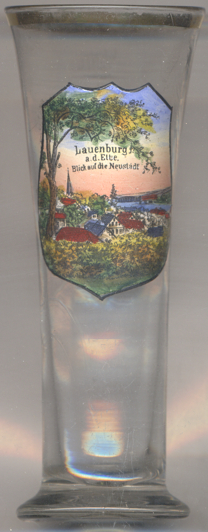

|
| DEUTSCHLAND | GERMANY |
| Bundesland: Schleswig-Holstein | |
| Kreis: Herzogtum Lauenburg |
 Lauenburg / Elbe is situated at an elevation of 49 m on the right, norgthern bank of the river
Elbe, which here forms the border between Germany's states of Schleswig-Holstein and Lower Saxony, thus making it
Schleswig-Holstein's southernmost town. The municipality has a population of about 11,500 (2017).
Lauenburg / Elbe is situated at an elevation of 49 m on the right, norgthern bank of the river
Elbe, which here forms the border between Germany's states of Schleswig-Holstein and Lower Saxony, thus making it
Schleswig-Holstein's southernmost town. The municipality has a population of about 11,500 (2017).
The town was founded in 1182 by duke Bernhard III of Saxony from the Ascanian dynasty, the ancestor of the Dukes of
Lauenburg. It took its name from that of the castle of Lowenborch (erected here between 1181 and 1182), deriving
from Lave, the Polabian-language name of the Elbe (compare modern Czech Labe). Saxe-Lauenburg was a duchy
until 1 July 1876, when it was incorporated into the Royal Prussian Province of Schleswig-Holstein. Lauenburg served
as the ducal capital until 1616, when the castle burnt down. In 1619 the capital was moved to Ratzeburg.
The area of the duchy was roughly identical with that of today's district. In medieval times Lauenburg was a waypoint on
the Old Salt Route, while today it is the southern terminus of the Elbe–Lübeck Canal. During the Napolenic times,
Lauenburg between 1810 and 1813 was part of the Département des Bouches de l'Elbe of the French Empire. Following
the Napoleonic Wars, Lauenburg was ceded by Prussia to Denmark in exchange for the region of Pomerania. In 1865, following
the Second Schleswig War and the Gastein Convention, Schleswig became part of Prussia, Holstein
became Austrian, and Lauenburg again part of Prussia, the style Duke of Lauenburg was incorporated into the styles of the
Prussian sovereign. Otto von Bismarck, the first Chancellor of the German Empire, in 1871 was given the title Prince of
Lauenburg and in 1890 also that of Duke in Lauenburg (although he never used these titles personally). After World
War II, between 1945 and 1982 Lauenburg served as West German inner German border crossing for cars travelling between
the Soviet Zone of occupation in Germany (till 1949), thereafter the East German Democratic Republic, or West Berlin and the
British zone of occupation (till 1949) and thereafter the West German Federal Republic of Germany.
[https://de.wikipedia.org/wiki/Lauenburg/Elbe, https://en.wikipedia.org/wiki/Lauenburg]
![[scale]](lineal.jpg)